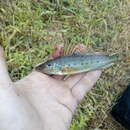Diagnostic Description
provided by Fishbase
Distinguished uniquely from its congeners by having roundish dark spots on body, mostly in 3 rows, first below dorsal base, and 50-55 + 4-5 scales along lateral line. Can be further separated from other species of the genus by having 17-19 dorsal spines (Ref. 59043).
Life Cycle
provided by Fishbase
""Female lays slightly sticky eggs in several portions: first at 6-8°C, second at 12-14°C. Eggs hatch in 6-8 days at 14-16°C. Newly hatched larvae first lie on bottom; at 9 days (when pectorals are developed), they actively move to middle water layers and drift downstream. At 12 days (6.5mm) they start active feeding on small invertebrates in shallow shoreline habitats" (Ref. 59043)."
Morphology
provided by Fishbase
Dorsal spines (total): 1719
Trophic Strategy
provided by Fishbase
Found in flowing waters and lakes with clear water. Also inhabits rapids during summer. Occurs over sand and gravel bottom but prefers hard compact sand. Usually crepuscular but feeds also during daytime. Preys predominantly on benthic invertebrates (crustaceans, insect larvae, molluscs), rarely on fish. Forms small schools. In September, this species starts forming large schools and moves to deeper places and remains inactive until ice melts. Does not undertake long distance migrations (Ref.59043).
- Recorder
- Grace Tolentino Pablico
Biology
provided by Fishbase
Found in flowing waters and lakes with clear water. Also inhabits rapids during summer. Occurs over sand and gravel bottom but prefers hard compact sand. Usually crepuscular but feeds also during daytime. Preys predominantly on benthic invertebrates (crustaceans, insect larvae, molluscs), rarely on fish. Forms small schools. In September, starts forming large schools and moves to deeper places and remains inactive until ice melts. Does not undertake long distance migrations. Spawns in small schools river stretches with heavy current and sand or gravel bottom (Ref.59043).
Donets ruffe
provided by wikipedia EN
The Donets ruffe (Gymnocephalus acerina) is a species of perch native to eastern Europe where it occurs in the basins of the Black Sea and the Sea of Azov. They inhabit freshwater lakes and rivers usually over hard compacted sand. They are predominantly crepuscular and prey mostly on invertebrates (crustaceans, insect larvae, mollusks), rarely on fish. They are inactive during winter months, and usually move to deeper places until the ice melts. Spawning occurs in small rivers with heavy currents. This species reaches a length of 21 centimetres (8.3 in) SL.[2]
References

- license
- cc-by-sa-3.0
- copyright
- Wikipedia authors and editors
Donets ruffe: Brief Summary
provided by wikipedia EN
The Donets ruffe (Gymnocephalus acerina) is a species of perch native to eastern Europe where it occurs in the basins of the Black Sea and the Sea of Azov. They inhabit freshwater lakes and rivers usually over hard compacted sand. They are predominantly crepuscular and prey mostly on invertebrates (crustaceans, insect larvae, mollusks), rarely on fish. They are inactive during winter months, and usually move to deeper places until the ice melts. Spawning occurs in small rivers with heavy currents. This species reaches a length of 21 centimetres (8.3 in) SL.
- license
- cc-by-sa-3.0
- copyright
- Wikipedia authors and editors

